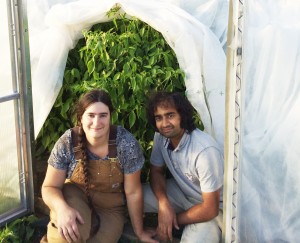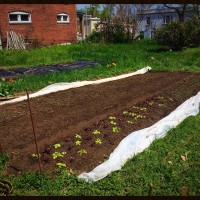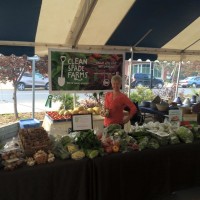Adithya Ramachandran turned his gardening addiction into a business by starting his own a backyard garden. After he graduated from university with a Master’s degree, he started working as a research assistant in a wheat lab. “Wheat is okay,” he says, but veggies are far more interesting.”
His mom introduced Adithya to gardening when he was 11 and he was instantly hooked. He grew tomatoes and peppers on his balcony as a teenager and always imagined myself doing this the rest of my life, although he never considered the economics of it at that time.
He also set up a compost pile inside a cardboard box on the balcony. It got to the point where his parents started to worry about his “gardening addiction that beautifies the downtown core.” After he graduated from university, he realized that the farmers’ markets in Saskatoon were undersupplied with certain vegetables at certain times of the year, while the local food movement was becoming increasingly popular. He saw this as the perfect opportunity to see if he could make a living out of doing what he loved.
His wife, Jenny Menat, (who helps him farm full time) does not come directly from a farming background either, although her paternal grandfather was a vegetable farmer in France. She knew that her grandparents often struggled to make ends meet, but Adithya convinced her that SPIN was financially viable in a market like Saskatoon’s.
Spinach was the first crop that Adithya and his wife grew to sale in the backyard garden of their apartment in 2011. Their total growing space their first year as urban farmers was 1,200 sq. ft. In addition to their yard, they used the yards of two neighbors. They grew an early crop of spinach with low tunnels and sold it through the “Little Market Store” at the Saskatoon Farmers’ Market while waiting for their application to be processed. Then they met SPIN-Farming’s creator, Wally Satzewich, at market, and he showed them the advantages of pre-bagging produce and mix-match pricing.
They started by selling at the Saskatoon Farmers market. But how did they get the word out about their new business? Adithya said he used a mix of Facebook and word-of-mouth, but it took a long time to get established.
“Ultimately, direct interaction with our customers spread the word for us better than we could have on our own.”
Adithya realized that there was very little in the way of ethnic vegetables available locally grown in Saskatoon. Many are not that difficult to grow and they decided to capitalize on that. Some of their more profitable ethnic vegetables include tomatillos, certain types of hot peppers, and eggplant. Adithya and his wife also sell to local restaurants as well.
“In the beginning, this approach was not very successful, partly because we started selling at a weekday market. Our success improved after a couple of years at the market once we switched to weekend markets.”
As Adithya’s business started to grow he decided to expand, but why? Adithya with a small sized garden, found that his expenses were too high a % of our sales. In addition, he noticed that customers gravitated towards vendors who show an abundance of product available.

This is the backyard garden Adithya and Jenny used in 2011 to start their urban farm. The 100 sq. ft. greenhouse was homemade, and got the job done.
Adithya and his wife decided to buy a farm to help cut down on inter-plot commute time and be able to install and monitor season extension structures. This allowed him to expand his business.
For starters Adithya and his wife are able to be at the farmers market about 30 weeks (a year) now, compared to around 20 weeks when the began. Their target is 40 weeks within two years.
Their expansion has also increased their production volumes which averaged around 400 units a week in 2015, compared to less than 100 when they began. Their goal is to increase to 600 units/week in two years. The farm has also helped to expand their crop repertoire. They still focus on ethnic crops they started out with, which they grow in larger volumes. They also grow a fair amount of “conventional” crops such as beet bunches, spinach, radishes, chard, kale, summer squash.
Even though they now own a farm that is 120 acres, Adithya and Jenny still plan on only using about a half acre, or 20,000 sq. ft. to grow commercially. This will allow them to continue doing all the work themselves.
If you want to find out more about growing plan and business model as Adithya Ramachandran and Jenny Menat to start a home -based backyard farm, click here. If you’re not ready to go all-in just yet, get a taste of what starting a backyard-scale farming business is like from our members with a month-to-month membership here.









